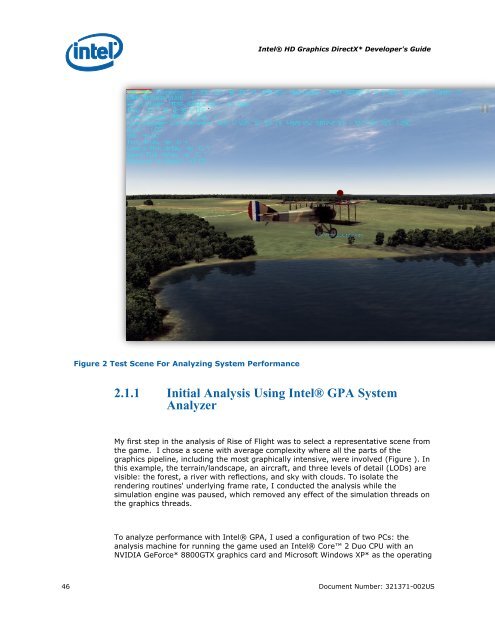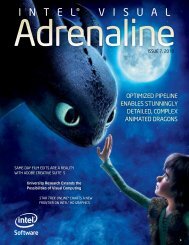Intel HD Graphics DirectX Developer's Guide (Sandy Bridge)
Intel HD Graphics DirectX Developer's Guide (Sandy Bridge)
Intel HD Graphics DirectX Developer's Guide (Sandy Bridge)
You also want an ePaper? Increase the reach of your titles
YUMPU automatically turns print PDFs into web optimized ePapers that Google loves.
Figure 2 Test Scene For Analyzing System Performance<br />
<strong>Intel</strong>® <strong>HD</strong> <strong>Graphics</strong> <strong>DirectX</strong>* <strong>Developer's</strong> <strong>Guide</strong><br />
2.1.1 Initial Analysis Using <strong>Intel</strong>® GPA System<br />
Analyzer<br />
My first step in the analysis of Rise of Flight was to select a representative scene from<br />
the game. I chose a scene with average complexity where all the parts of the<br />
graphics pipeline, including the most graphically intensive, were involved (Figure ). In<br />
this example, the terrain/landscape, an aircraft, and three levels of detail (LODs) are<br />
visible: the forest, a river with reflections, and sky with clouds. To isolate the<br />
rendering routines' underlying frame rate, I conducted the analysis while the<br />
simulation engine was paused, which removed any effect of the simulation threads on<br />
the graphics threads.<br />
To analyze performance with <strong>Intel</strong>® GPA, I used a configuration of two PCs: the<br />
analysis machine for running the game used an <strong>Intel</strong>® Core 2 Duo CPU with an<br />
NVIDIA GeForce* 8800GTX graphics card and Microsoft Windows XP* as the operating<br />
46 Document Number: 321371-002US













